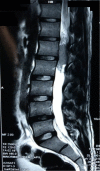Spinal myxopapillary ependymoma with interval drop metastasis presenting as cauda equina syndrome: case report and review of literature
- PMID: 27757435
- PMCID: PMC5067269
- DOI: 10.21037/jss.2016.08.06
Spinal myxopapillary ependymoma with interval drop metastasis presenting as cauda equina syndrome: case report and review of literature
Abstract
Myxopapillary ependymoma is a benign slow-growing tumour, arising predominantly in the region of the filum terminale. It has been designated histologically as grade I neoplasm according to the 2007 WHO classification. Despite this benign character dissemination and metastasis along the cerebrospinal axis and metastasis to distant sites have occasionally been reported. There have been previously reported cases of drop metastasis from MPE, however in three of these cases the drop metastasis was diagnosed with concurrent primary spinal MPE. There has been only one previously published case of interval drop metastasis in a case of operated spinal MPE in literature. We hereby present the second case of interval drop metastasis in a case of conus MPE, with history of having undergone a subtotal resection and post operative adjuvant radiotherapy prior to second surgery. The patient presented months after the primary surgery with symptoms of cauda equina syndrome attributable to the drop metastasis.
Keywords: Myxopapillary ependymoma; adjuvant radiotherapy; cauda equina syndrome; drop metastasis.
Conflict of interest statement
The authors have no conflicts of interest to declare.
Figures





Similar articles
-
A rare case of an intramedullary metastasis of a myxopapillary ependymoma.Surg Neurol Int. 2019 May 10;10:83. doi: 10.25259/SNI-96-2019. eCollection 2019. Surg Neurol Int. 2019. PMID: 31528421 Free PMC article.
-
Primary Seeding of Myxopapillary Ependymoma: Different Disease in Adult Population? Case Report and Review of Literature.World Neurosurg. 2017 Mar;99:812.e21-812.e26. doi: 10.1016/j.wneu.2016.12.022. Epub 2016 Dec 29. World Neurosurg. 2017. PMID: 28040529 Review.
-
Concomitant localization of a myxopapillary ependymoma at the middle thoracic part of the spinal cord and at the distal part of the filum terminale. Case report.J Neurosurg Sci. 2008 Sep;52(3):87-91. J Neurosurg Sci. 2008. PMID: 18636054
-
Primary multifocal myxopapillary ependymoma of the filum terminale.J Neurosurg Sci. 2016 Dec;60(4):424-9. Epub 2015 Jul 8. J Neurosurg Sci. 2016. PMID: 26154385
-
Long-Term Surgical Resection Outcomes of Pediatric Myxopapillary Ependymoma: Experience of Two Centers and Brief Literature Review.World Neurosurg. 2020 Apr;136:e245-e261. doi: 10.1016/j.wneu.2019.12.128. Epub 2019 Dec 30. World Neurosurg. 2020. PMID: 31899399 Review.
Cited by
-
Resection of disseminated recurrent myxopapillary ependymoma with more than 4-year follow-up: operative nuance for prolonged prone position. Illustrative case.J Neurosurg Case Lessons. 2022 Apr 11;3(15):CASE2235. doi: 10.3171/CASE2235. Print 2022 Apr 11. J Neurosurg Case Lessons. 2022. PMID: 36303501 Free PMC article.
-
A rare case of an intramedullary metastasis of a myxopapillary ependymoma.Surg Neurol Int. 2019 May 10;10:83. doi: 10.25259/SNI-96-2019. eCollection 2019. Surg Neurol Int. 2019. PMID: 31528421 Free PMC article.
-
Myxopapillary ependymoma with interval postoperative CSF seeding: A report of an unusual case.Radiol Case Rep. 2021 Oct 10;16(12):3838-3843. doi: 10.1016/j.radcr.2021.09.022. eCollection 2021 Dec. Radiol Case Rep. 2021. PMID: 34691347 Free PMC article.
-
Multifocal lumbar myxopapillary ependymoma presenting with drop metastasis: a case report and review of the literature.Spinal Cord Ser Cases. 2022 Apr 22;8(1):43. doi: 10.1038/s41394-022-00513-x. Spinal Cord Ser Cases. 2022. PMID: 35459220 Free PMC article. Review.
-
Recurrent Extradural Myxopapillary Ependymoma With Oligometastatic Spread.Front Oncol. 2019 Nov 28;9:1322. doi: 10.3389/fonc.2019.01322. eCollection 2019. Front Oncol. 2019. PMID: 31850213 Free PMC article.
References
-
- McLendon RE, Rosenblum MK, Schiffer D, et al. Myxopapillary ependymoma. In: Louis DN, Ohgaki H, Weistler OD, et al. editors. WHO classification of tumors of the central nervous system. Lyon: International Agency for Research on Cancer, 2007:72-3.
-
- Kernohan JW. Primary tumors of the spinal cord and intradural filum terminale. In: Penfield W. Cytology and cellular pathology of the nervous system. New York: Hoeber; 19323;3:993-1025.
Publication types
LinkOut - more resources
Full Text Sources
Other Literature Sources
